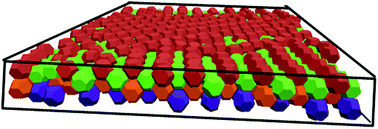Phase behavior of polyhedral nanoparticles in parallel plate confinement†
Abstract
Monte Carlo simulations are used to investigate the phase behavior of hard cubes, truncated cubes, cuboctahedra and truncated octahedra when confined between two parallel hard walls. The walls are separated by a distance H* which is varied to accommodate a different number of layers, from a monolayer up to approximately 5 layers, hence allowing us to probe the transitional phase behavior as the system goes from a quasi-2D geometry to a quasi-3D bulk behavior. While our results do reveal some phases whose structures resemble those that have been observed before for such systems in 2D and 3D spaces, other phases are also detected, including buckled phases, rotator plastic phases, and solids with significant translational disorder. Ordered phases formed for H* values that are a little too narrow to accommodate an additional particle layer are particularly interesting as they tend to have complex structures. The maximum density for such frustrated phases is low compared to that of non-frustrated ones for the same system at different H*. As the asphericity in the shapes is reduced, the simulated phases show structural features that approach those of the phases that have been reported for hard spheres under similar confinement.


 Please wait while we load your content...
Please wait while we load your content...